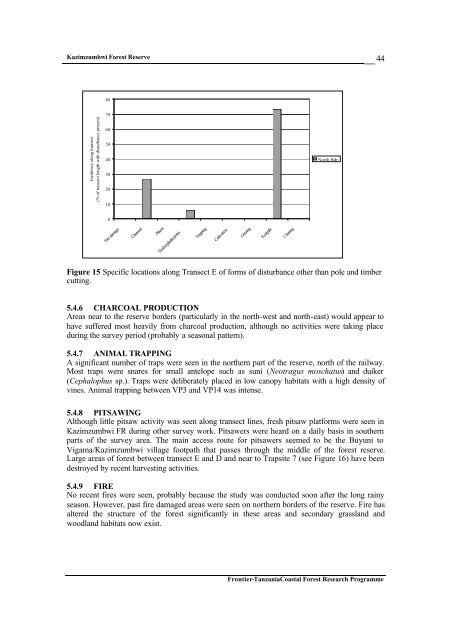Frontier Tanzania Environmental Research REPORT 110 ...
Frontier Tanzania Environmental Research REPORT 110 ...
Frontier Tanzania Environmental Research REPORT 110 ...
You also want an ePaper? Increase the reach of your titles
YUMPU automatically turns print PDFs into web optimized ePapers that Google loves.
Kazimzumbwi Forest Reserve<br />
44<br />
80<br />
Incidence along transect<br />
(% of transect length with disturbance present)<br />
70<br />
60<br />
50<br />
40<br />
30<br />
20<br />
10<br />
North Bdr<br />
0<br />
Fire damage<br />
Charcoal<br />
Pitsaw<br />
Timber/planks/poles<br />
Trapping<br />
Cultivation<br />
Grazing<br />
Footpath<br />
Clearing<br />
Figure 15 Specific locations along Transect E of forms of disturbance other than pole and timber<br />
cutting.<br />
5.4.6 CHARCOAL PRODUCTION<br />
Areas near to the reserve borders (particularly in the north-west and north-east) would appear to<br />
have suffered most heavily from charcoal production, although no activities were taking place<br />
during the survey period (probably a seasonal pattern).<br />
5.4.7 ANIMAL TRAPPING<br />
A significant number of traps were seen in the northern part of the reserve, north of the railway.<br />
Most traps were snares for small antelope such as suni (Neotragus moschatus) and duiker<br />
(Cephalophus sp.). Traps were deliberately placed in low canopy habitats with a high density of<br />
vines. Animal trapping between VP3 and VP14 was intense.<br />
5.4.8 PITSAWING<br />
Although little pitsaw activity was seen along transect lines, fresh pitsaw platforms were seen in<br />
Kazimzumbwi FR during other survey work. Pitsawers were heard on a daily basis in southern<br />
parts of the survey area. The main access route for pitsawers seemed to be the Buyuni to<br />
Vigama/Kazimzumbwi village footpath that passes through the middle of the forest reserve.<br />
Large areas of forest between transect E and D and near to Trapsite 7 (see Figure 16) have been<br />
destroyed by recent harvesting activities.<br />
5.4.9 FIRE<br />
No recent fires were seen, probably because the study was conducted soon after the long rainy<br />
season. However, past fire damaged areas were seen on northern borders of the reserve. Fire has<br />
altered the structure of the forest significantly in these areas and secondary grassland and<br />
woodland habitats now exist.<br />
<strong>Frontier</strong>-<strong>Tanzania</strong>Coastal Forest <strong>Research</strong> Programme

















